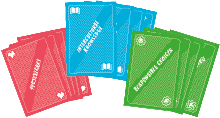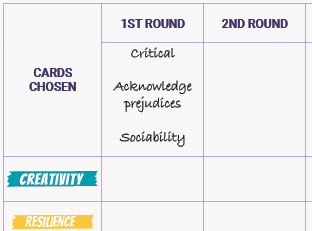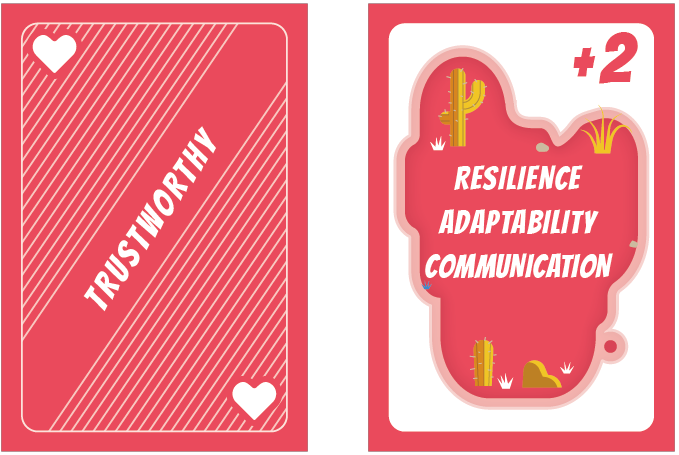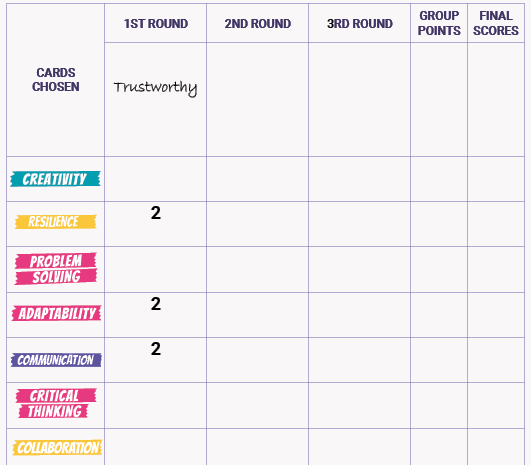1
GameOn: The intermediate steps of Incluship
GameOn: The intermediate steps of Incluship
Sobre
This activity will guide you through the second step of using Incluship, the gamified tool that was created by Idealúdica and the partners of the “GameOn” project to assess inclusion competences acquired through game design.
In each intermediate evaluation activity, each participant must identify specific actions or moments since the last activity of Incluship where they put in practice attitudes, knowledge and skills related to the social inclusion competences. This individual reflection will then be shared with the rest of the group.
The identified actions will show the participants what inclusion competences they are developing, and how they are contributing to achieving the objective set at the beginning of the project.
As the facilitator, you should have decided before starting the process how many intermediate evaluation sessions you want to carry out during your project (between 1 and 3).
You should repeat the step described in this activity for each of the evaluation sessions you planned to do. Each of these sessions should last about 30 minutes.
1. Choosing exploration cards
Place the exploration cards with the colored side face up on 3 different tables or spaces, separating them according to their type into:
Skills – Green cards
Knowledge – Blue cards
Attitudes and behaviors – Red cards

Invite now the participants to go freely to one of the 3 available tables/spaces and to choose the card with the element they think that they’ve developed the most during the project, until that moment.
Without picking up the cards, turning them over or moving them, invite participants to simply write the name of the chosen card in their personal exploration journal, under the column for the current assessment session (first, second, or third). Then, encourage them to go to another table/space and continue like this until they have selected 1 card of each type/color.
See the example below:

2. Sharing in the group
When all participants have chosen their 3 cards (one of each type) and written them down in their exploration journal, invite them back to the circle and to share the reasoning behind their choices with the rest of the group.
In turns, each participant will explain which cards they have chosen and when they have put their content in practice, during the project, according to their own point of view.
For example:
If a participant has chosen the "Critical" attitude card, they must explain during which moment or situation in the activities they have shown that attitude or behavior.
If they have chosen the “Acknowledge prejudices and privileges” card, they must explain when they have learned or were aware of that.
If they have chosen the card "Sociability", they must explain when they have exercised this skill.
If working with a big group (15+ participants), this step can be done in small teams instead.
3. Scoring of exploration points
When all participants have shared their card choices, ask them to return to the tables and to now turn the cards over and record in their explorer’s journals the exploration points that they’ve earned thanks to their selected cards.
For example:
If a participant has chosen the “Trustworthy” card, they will gain 2 points on the “Resilience” island, 2 points on the “Adaptability” island, and another 2 points on the “Communication” island. They shall mark all points in their journal, in the relevant competence islands.


To end the session, remind participants that the points obtained show how each one is working and developing the different inclusion competences throughout the project.
4. The storm effect (optional)
If during the game design or creative process there has been a moment of intentional exclusion, lack of respect or some element that has made the process difficult, the facilitator or the members of the group can incorporate to the Incluship board and the islands the “storm effect” token.

The storm effect stops the competence islands exploration until the conflict is discussed and resolved.
To end the storm, the facilitator will develop a group dynamic (they will choose what’s the best action to resolve the conflict) to ensure the group’s commitment to the resolution of the bad situation, attitude or action.
When the facilitator and/or group evaluate that the conflict is well resolved, the storm will end and the exploration can continue.
It’s not mandatory to use the storm effect, but it’s highly recommended to explain to participants that there exists this possibility to highlight some conflict or bad situation that isn’t getting resolved.
To summarise…
- Each participant chooses 3 exploration cards (one of each colour)
- Participants share in the group the reasons behind their choices
- Going back to the cards, participants mark the points for each competence
- Furthermore, the facilitator or the members of the group can use the storm token to stop the exploration and highlight a conflict, intentional exclusion, lack of respect or some element that has made the process difficult in the last activities of the game design or creative project
The following playlist activity will guide you through the final step of the process, keep going to learn more about Incluship!
This activity is part of the wider educational effort of the international partnership “GameOn” to promote inclusion, participation, and critical thinking through game design. Learn more about this partnership here.
Expert partners:
Nexes (ES) – the lead partner, Idealúdica (ES), Universitat de Barcelona (ES), BalkanIdea Novi Sad (SR), Nectarus (LT), Associazione Interculturale NUR (IT).
Co-funded by the Erasmus+ Programme of the European Union
Cover image from Incluship test carried out in Spain.
Recursos
Obter uma medalha da atividade
GameOn: Incluship step 2 Obter esta medalha
The owner of this badge has learned in detail about the second step to implement Incluship in a learning group process and is now able to facilitate it.
Incluship is a gamified tool that was created by Idealúdica and the partners of the “GameOn” project to assess inclusion competences acquired by participants in a game design group process.
This activity is part of the wider educational effort of the international partnership “GameOn” to promote inclusion, participation, and critical thinking through game design. Learn more about this partnership here.
Tarefas
Tarefa n.º 1
Evidência verificada por: auto-aprovado
Read the guide about the second step of implementing Incluship and share your thoughts on one or more of the following questions to earn the activity badge:
- Are there any challenges that you can foresee when facilitating this step of the process? If so, how would you overcome them?
- What are the elements you found most interesting in the second step of the process?
Competências
ESCO
#transversal competences/skills
ESCO
#assessment methods
ESCO
#conduct self-assessment
ESCO
#team-working
ESCO
#promover a inclusão
Organizadores
GameOn - Game Design for Inclusion
Utilizado em playlists
GameOn: Assessing competences with Incluship
GameOn - Game Design for InclusionA Badgecraft é a anfitriã desta plataforma e desenvolve-a em conjunto com as principais organizações educativas. O programa Erasmus+ da União Europeia concedeu um cofinanciamento para a construção da primeira versão desta plataforma. Contacto: support@badgecraft.eu.
Plataforma
Alterar idioma:

